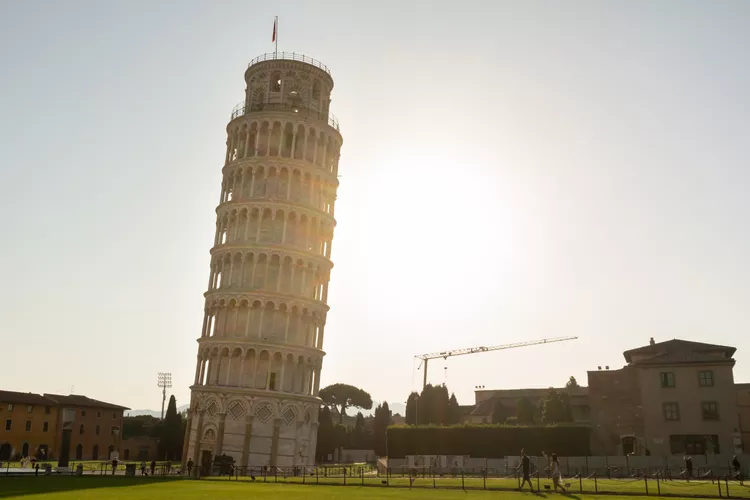Content Summary
The city of Pisa, located in northern Tuscany approximately 50 miles west of Florence, is home to the iconic 13th-century Leaning Tower of Pisa (pronounced peez-ah, not pizza). The famously lopsided tower is one of Italy’s top attractions, drawing millions of visitors each year to marvel at its fascinating, if failed, engineering and glorious architecture.
You’ll find the Leaning Tower of Pisa, along with the Duomo (cathedral) and Battistero (baptistery) on the Piazza del Duomo, or as it is more commonly called, the Campo dei Miracoli (field of miracles).
History of the Leaning Tower
Construction began in the 12th century on the bell tower or campanile of the Duomo. The white marble, cylindrically shaped tower, adorned with Arabic-inspired geometric patterns, is considered the finest example of Romanesque architecture in all of Tuscany. Moreover, it took more than 200 years to complete the tower, but the leaning began long before the last stone was laid. Because of the soft ground underneath and the lack of an adequate foundation, the tower started leaning as early as when builders had completed the third story.
To counteract the tilting and uneven weight distribution, designers in the 13th century constructed successive floors taller on one side than the other, resulting in a slight curve to the tower. Yet for 800 years, it continued to fall at almost two millimeters a year until the heavy bells were removed and it was anchored into the ground. Today, engineers have deemed the tower safe and stable, concluding that it has finally stopped moving.
What to Do at the Leaning Tower and Campo dei Miracoli
- Climb to the top of the tower: Visitors can enjoy an ascent up the 297 steps of the spiral staircase after a brief presentation by staff about the tower’s history and some fun facts. The tower, standing 184 feet (56 meters) tall, has eight levels, with six open galleries offering stunning views of the city and surrounding countryside.
- Visit the Duomo and museum: The Duomo is impressive with its striking four-tiered facade and white colonnades. Inside, a 14th-century marble pulpit and the tomb of Emperor Henry VII can be found, along with a splendid mosaic of Christ in Majesty.
- Go inside the Baptistery (Battistero): Known for its astonishing acoustics, the circular baptistery was built in an ornate Gothic style. Notable elements include carved pulpit reliefs and the beautiful white and grey striping of the interior.
- Walk around the Camposanto (cemetery): Often overlooked, this graveyard is lined with covered arcades filled with gravestones and funerary monuments from Pisa’s Renaissance aristocracy.
- Visit the Sinopie Museum: Housed in a former hospital, this museum showcases the original sketches behind the frescoes of the Camposanto, which were found during restoration efforts post-WWII.
How to Visit the Campo dei Miracoli
Location: Campo dei Miracoli, 56100 Pisa, Italy
Admission: Visits to the Tower cost €18 and can be reserved up to 20 days in advance through the official website for the Campo dei Miracoli attractions. Entrance to the Duomo is free. Prices to visit additional monuments include €5 for one, €7 for two, and €8 for three.
It is essential to purchase tickets for the Leaning Tower in advance, as entry is limited and available via a timed ticket system.
Hours: Campo dei Miracoli: Open daily, closed on January 1 and December 25. Tower: Open daily 8am-8pm (times may vary due to special events); Duomo: Open daily 10am-8pm; Baptistery: Open daily 8am-8pm; Camposanto: Open daily 8am-10pm; Opera del Duomo Museum: Daily 8am-8pm.
Note: Admission is free for visitors with disabilities and one companion, as well as for children 10 and under.
Nearby Attractions
The Orto Botanico is one of Europe’s oldest botanical gardens, offering a tranquil escape from the crowds.
Piazza dei Cavalieri is located on the north side of Pisa’s Palazzo dei Cavalieri. Although now a prestigious university’s home, it once served as headquarters for the Calvalieri di Stanto Stefano, giving it historical significance.





